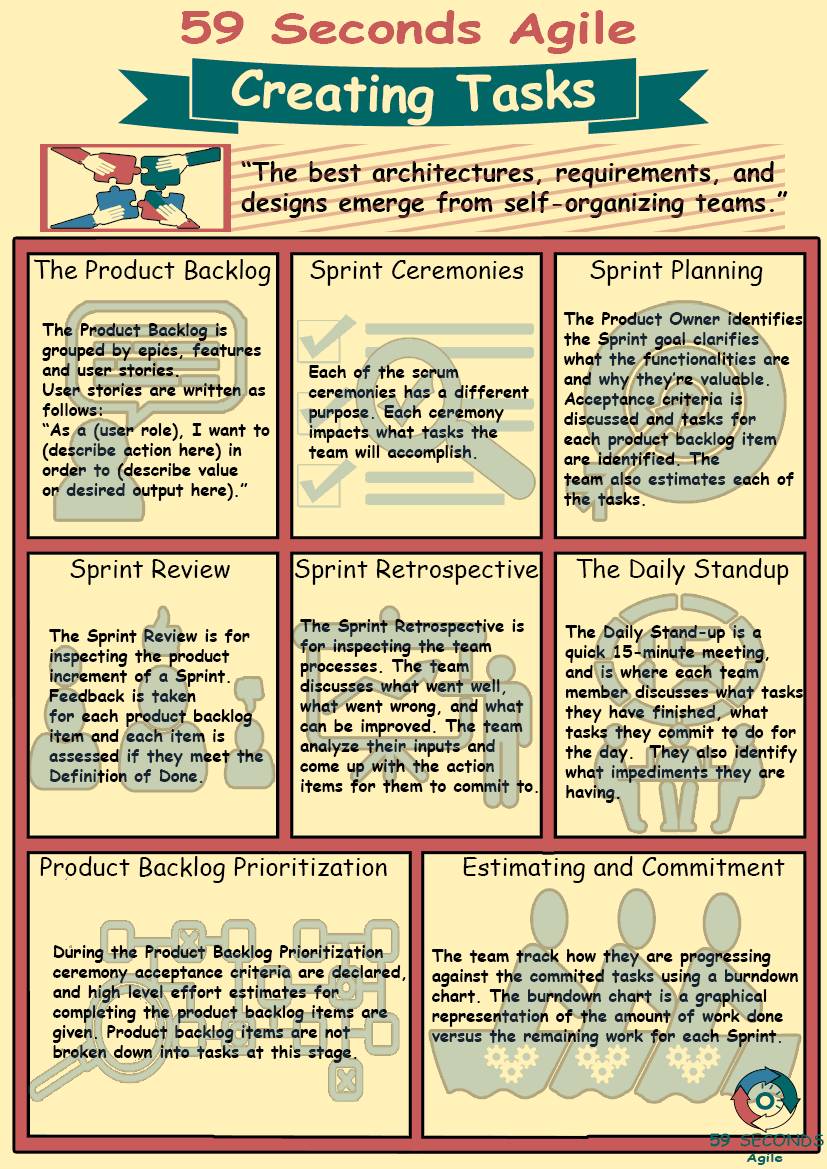Who is responsible for Generating Agile Tasks and how do they do it? Generating Agile Tasks is an important part of an Agile project.
Agile User Stories and Tasks
A 59 Seconds Agile Video Animation
Generating Agile Tasks and User Stories for Developers – Part 2
A 59 Seconds Agile Article
Approval
Next, the Scrum team must approve the prioritized user stories and break them down into tasks. If the focus is on tasks, why mention user stories first? Because the process of breaking user stories down into definite tasks requires a lot of effort. Not only does it require effort, but these tasks may change over the course of the project. Breaking all user stories into tasks at the very beginning of the project wastes effort. If anything in development changes, these tasks may be rendered useless. Instead, the Scrum team waits until user stories for the immediate next sprint are selected.
Developers are beneficial to this step because they understand the logical divisions in a feature. What seems like a single piece of work to other roles, may have distinct parts to a developer. In addition to the tasks for other roles, developers can break a user story into tasks that allow multiple developers to work on a story at the same time. Once they have separated the tasks, these tasks are added to a task list for the individual user story.
Generating Agile Tasks: Estimation
After user stories have been broken down, and the tasks have been approved, the Scrum team must estimate how long each task will take. While similar to the story points estimation of user stories, task estimations focus on hours and days of work. This gives the Scrum team a good idea of about how much time the tasks will require, and whether development is behind pace for a user story.
Developers are vital for the estimation stage since only a developer knows how long coding for a task might take. A seasoned developer has seen enough work to have a good idea of how long any piece of code will take. With a team of developers, these estimations can be averaged out. Bias from the area of expertise or seniority will generally cancel out and yield a close estimate.
Generating Agile Tasks: Priority
The last step of creating tasks is prioritizing them in the sprint backlog. It is important to get work done in the most logical order. Software development is a building process, and working from the top down rarely produces quality code. Developing the most critical parts first, and gradually adding in new components, enables the continuous delivery of value within the product.
With their understanding of software, developers are the best equipped to prioritize tasks. They know where the most important pieces are. Developers also know if the code can be recycled, to reduce the effort for future tasks. With a good team of developers, tasks can be prioritized in a way that generates working code quickly.
There are several steps in creating tasks for Agile software development. While developers do most of their work after the tasks are created, they also play an important part in the creation process. When properly included, developers can help make sure tasks are created properly, and ordered in a way that yields the best results for the project.
Prev <— Continue Reading —> Next
Learn More: Agile User Stories & Tasks
User Stories Applied
A 59 Seconds Agile Book Review
User Stories Applied by Mike Cohn is one of our favourite books on Agile User Stories. The book starts with an overview into user stories, and details what a user story is and the different aspects of them. He then discusses how to go about writing a user story, and provides details of the INVEST criteria that can be used to determine if the story is meeting all of its objectives. Next Mike gives an in depth discussion of who user stories are written for and where to begin when gathering the details for them. The book then discusses acceptance testing user stories, including how to go about specifying these criteria and the responsibilities of the development team and customers during this process.
Prev <— Continue Reading —> Next
Learn More: Agile User Stories & Tasks
Agile User Stories and Tasks
A 59 Seconds Agile Infographic

Prev <— Continue Reading —> Next
Learn More: Agile User Stories & Tasks
Our Favourite Agile Books
We found these books great for finding out more information on Agile Scrum:
